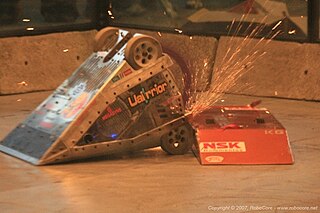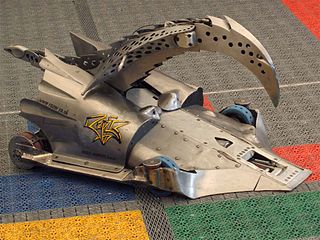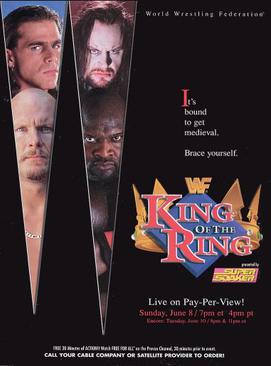BattleBots is an American robot combat television series and company. The show is an adaptation of the American Robot Wars competitions hosted in the mid–late 1990s by Marc Thorpe, in which competitors design and operate remote-controlled armed and armored machines designed to fight in an arena combat elimination tournament. The same competitions inspired the British TV program Robot Wars, which acquired the name in 1995.

Robot Wars is a British robot combat television series created by Tom Gutteridge and Stephen Carsey which aired from 1998 to 2004 and from 2016 to 2018. The series involves teams of amateur and professional roboteers operating remote controlled robots to fight against each other in an arena, which features hazards and the heavier "House Robots" which are hostile to all combatants. The first two series also included assault and trial courses.

Firestorm is a fictional superhero appearing in American comic books published by DC Comics. He was created by Gerry Conway and Al Milgrom. Ronnie Raymond and Martin Stein first fused together to become Firestorm in Firestorm, the Nuclear Man #1. Jason Rusch debuted as a modern update of the character in Firestorm #1, and was created by Dan Jolley and ChrisCross.

Chaos 2 is a combat robot from the UK Television Series Robot Wars, designed and built by self-employed mechanic George Francis, from Ipswich, and operated by Team Chaos. Twice winner of the UK Robot Wars Championship and the only robot with that distinction, it was the first robot to use its flipper to throw its opponents out of the arena altogether.This machine was also the first to defeat Hypno-Disc in Series 3. Its flipper is commonly considered to be one of the most powerful in Robot Wars, although it is not as powerful as the catapult-style flipper of Wheely Big Cheese. However, its weapon is superior in terms of efficiency, but has a limited supply of CO2, which provides the power for the weapon. The robot has been reincarnated several times over the years, previously appearing as Robot The Bruce and Chaos. Its flipper was also used as a self-righting mechanism when the robot was inverted, flipping the entire robot over in a half-somersault so it could continue fighting.

Robot combat is a type of robot competition in which custom-built machines fight using various methods to incapacitate each other. The machines have generally been remote-controlled vehicles rather than autonomous robots.

Hypno-Disc was a contestant entry in the Robot Wars TV series, and was one of the first robots permitted to use the kinetic flywheel weapon. Hypno-Disc's design, however, was somewhat basic, and its high ground clearance made it an easy target for robots armed with flipping weapons, such as Chaos 2. Hypno-Disc was the creation of the Rose family — twin brothers Derek and David, and their father Ken. It was the first competitor robot recreated in toy form when the Robot Wars pullback toys were released.
Roadblock was a combat robot that competed on the British television series Robot Wars. Constructed in 1997 by A-level students from Bodmin Community College, the robot was initially called "Road Rage" but was renamed in response to a request from the programme's producers. Both names were derived from the robot's distinctive construction from metal roadsigns. Roadblock was champion of the first series of Robot Wars and finished in third place for the second series. Although Roadblock was armed with a circular saw weapon, its success was primarily due to its wedge-shaped body—Roadblock could drive underneath opponent robots and invert them, rendering many immobile.

Razer is a combat robot that competes on the British television series Robot Wars. It was constructed by Simon Scott and Ian Lewis from Bournemouth; the team later expanded to include webmaster Vincent Blood. Razer was designed and constructed in 1998 to participate in the second series of Robot Wars, but subsequent modifications and improvements enabled it to remain competitive until its retirement after the second series of Robot Wars Extreme. Despite gaining a reputation for being unreliable, it was champion of the fifth series of Robot Wars, runner-up in the sixth, and won the first two Robot Wars World Championships.
Tornado was a competitor on the UK TV series Robot Wars, noteworthy as the champion of the sixth series. It was built by Andrew Marchant, Bryan Moss and David Gamble, from Sawtry, near Huntingdon.
The Battle of Sutherland's Station was an American Civil War conflict fought on April 2, 1865, in Dinwiddie, Virginia during the Appomattox Campaign.
Robot Arena is an action video game series focused on robot building and fighting. It is based on television shows such as Robot Wars and Battlebots. There are three games in the series, Robot Arena released in 2001, Robot Arena 2: Design and Destroy released in 2003, and Robot Arena 3 released in 2016.
Typhoon 2 was a robot in the UK television series Robot Wars, noteworthy for being the final champion of the show before it was cancelled. It was a full-body spinner with cutting claws. In two battles in series 7, in which it competed, it knocked out the arena wall, causing the match to restart. It was created by the 870 Dreghorn Squadron's Air Cadets from the Air Training Corps and was painted to resemble the RAF crest. It was named after the Eurofighter Typhoon. The team also had a three-time middleweight champion called Typhoon, a lightweight called Typhoon Thunder which also made Typhoon Twins with Typhoon Lightning, and a featherweight called Typhoon Cadet. Gary Cairns, the team captain, later ran a three-dimensional printing business and fought in the 2016 Robot Wars with PP3D, which reached the second round group stage in its heat. Then, it lost, ironically, to Storm 2 in the decisive battle, before losing at the same stage a year later due to control problems in its battles.

Super Robot Wars J, is a tactical role-playing video game released for the Game Boy Advance developed by A.I and published by Banpresto.

BioHazard is a combat robot built by rocket scientist Carlo Bertocchini. It was the most successful robot in the heavyweight division of BattleBots. It is still considered one of the greatest and most successful combat robots of all time. BioHazard's weapon is an electric four-bar lifting arm used to lift other robots. The lifting arm has been described as a type of shovel, scoop, or a forklift mechanism. For much of its reign, BioHazard was notorious for being difficult to attack and get under due to hinged titanium wedge skirts on all sides and the low profile effected by its 4.5 inches (11 cm) height. The robot weighs 208 pounds (94 kg) and has a surface area of 3 feet (0.91 m) by 4 feet (1.2 m).

The 1997 King of the Ring was the fifth annual King of the Ring professional wrestling pay-per-view (PPV) event produced by the World Wrestling Federation that featured the 11th King of the Ring tournament. It took place on June 8, 1997, at the Providence Civic Center in Providence, Rhode Island.
Storm 2 is a robot that competed in the British television game show Robot Wars. It was a small invertible box-shaped robot with a wedge on the front. The robot was originally built with no weapons but the team was asked to add an active weapon in order to take part in the seventh series, so the team came up with a built-in lifting arm, very similar to the American robot BioHazard. However, it was not the weapon but the immense speed and power of the robot that did the most damage to its opponents, managing to throw The Steel Avenger out of the Arena in its Series 7 heat final. The robot competed in the seventh series of Robot Wars, winning The Third World Championship at the end of the series, having won the 16th seed into the competition by being victorious in the New Blood Championship of Extreme 2.

Robot Wars: Extreme Destruction is an action game developed by Climax Development and published by BBC Multimedia under their game development label Gamezlab in 2002 for the Game Boy Advance, Microsoft Windows and Xbox. It was given a release in the run-up to Christmas to build on the success of the three previous games, which had sold over 250,000 copies.

Safety in NASCAR has evolved into one of the biggest concerns in stock car racing's largest sanctioning body. Mainly after the death of Dale Earnhardt, a seven-time Winston Cup Series champion, NASCAR has decided to change all of their safety policies, such as the use of the HANS device. Since 2001, NASCAR has also changed the cars for the NASCAR Cup Series and the Xfinity Series. NASCAR's safety policy includes the racing fire suit, carbon fiber seating, and roof flaps.
In robot combat, a self-righting mechanism or srimech is a device used to re-right a robot should it get flipped. Biohazard of BattleBots was the first robot to self-right.

Robot Wars: Advanced Destruction is the third video game based on the British game show Robot Wars. It was the third of four games based on the show, with the first three selling over 250,000 copies. It was developed by Crawfish Interactive and published by BBC Multimedia and was released exclusively for the Game Boy Advance in 2001. It was also released in the US by Vivendi Universal Games. The game is based on Series 4 of Robot Wars.











